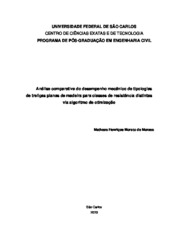Análise comparativa do desempenho mecânico de tipologias de treliças planas de madeira para classes de resistência distintas via algoritmo de otimização
Abstract
Wood is a viable choice for building systems, given its mechanical properties suitable for structural applications. In addition, wood is a renewable source, making it even more attractive for use in various applications for structural purposes. Aiming to understand the mechanical performance of two plane trusses under different loading conditions, a comparative study of the mechanical performance of two truss typologies - the modified Fan and Howe typologies - considering spans of 6, 9, 12 and 15 m, was carried out. In order to evaluate the influence of the material adopted in the construction process of the trusses, the species Cambará-rosa, Cupiúba, Angelim-pedra, Garapa and Jatobá, identified as species ID 01, ID 02, ID 03, ID 04 and ID 05, respectively, were characterized. The study was based on ABNT NBR 7190 (2022a) for truss dimensioning, besides applying the matrix analysis method for determining internal forces, nodal displacements and a swarm intelligence optimization algorithm to minimize the structure weight. The species characterization resulted in strength classes D20, D30, D40, D60, and D60, for the species named ID 01, ID 02, ID 03, ID 04, and ID 05, respectively. The results of the optimization process indicate that the Howe typology presented lower results for the objective function (weight of structure) in relation to the modified Fan truss. Furthermore, when the distribution of normal forces in the truss was analyzed, a correlation was observed with the characteristic strength in compression and tensile of the species, where the trusses with species of lower mechanical strength are more requested, while the trusses with species of higher mechanical strength are less requested. In this sense, it is possible to note that the Howe truss typology presents a larger amplitude in relation to the Modified Fan truss typology, in most of the conditions adopted for the ULS constraints. When analyzing the constraints associated with a deflection in the immediate condition, it was observed that values close to zero were obtained, which indicates that constraints of this nature limited the optimization process. In summary, wood turned out to be a sustainable and viable option for truss constructions, and that different wood species have distinct mechanical properties that should be considered when designing the structure. The matrix analysis methods and swarm intelligence optimization algorithms allowed the evaluation of internal efforts and nodal displacements in the trusses, as well as minimizing the weight of the structure. In addition, it is important to consider all constraints when dimensioning timber structures.
Collections
The following license files are associated with this item:

